Zhaojie Liu
Selection and Exploitation of High-Quality Knowledge from Large Language Models for Recommendation
Aug 10, 2025Abstract:In recent years, there has been growing interest in leveraging the impressive generalization capabilities and reasoning ability of large language models (LLMs) to improve the performance of recommenders. With this operation, recommenders can access and learn the additional world knowledge and reasoning information via LLMs. However, in general, for different users and items, the world knowledge derived from LLMs suffers from issues of hallucination, content redundant, and information homogenization. Directly feeding the generated response embeddings into the recommendation model can lead to unavoidable performance deterioration. To address these challenges, we propose a Knowledge Selection \& Exploitation Recommendation (KSER) framework, which effectively select and extracts the high-quality knowledge from LLMs. The framework consists of two key components: a knowledge filtering module and a embedding spaces alignment module. In the knowledge filtering module, a Embedding Selection Filter Network (ESFNet) is designed to assign adaptive weights to different knowledge chunks in different knowledge fields. In the space alignment module, an attention-based architecture is proposed to align the semantic embeddings from LLMs with the feature space used to train the recommendation models. In addition, two training strategies--\textbf{all-parameters training} and \textbf{extractor-only training}--are proposed to flexibly adapt to different downstream tasks and application scenarios, where the extractor-only training strategy offers a novel perspective on knowledge-augmented recommendation. Experimental results validate the necessity and effectiveness of both the knowledge filtering and alignment modules, and further demonstrate the efficiency and effectiveness of the extractor-only training strategy.
LLM-Alignment Live-Streaming Recommendation
Apr 07, 2025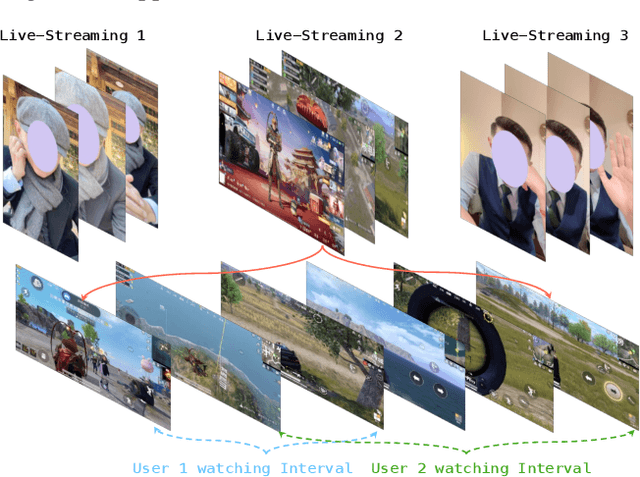



Abstract:In recent years, integrated short-video and live-streaming platforms have gained massive global adoption, offering dynamic content creation and consumption. Unlike pre-recorded short videos, live-streaming enables real-time interaction between authors and users, fostering deeper engagement. However, this dynamic nature introduces a critical challenge for recommendation systems (RecSys): the same live-streaming vastly different experiences depending on when a user watching. To optimize recommendations, a RecSys must accurately interpret the real-time semantics of live content and align them with user preferences.
FARM: Frequency-Aware Model for Cross-Domain Live-Streaming Recommendation
Feb 13, 2025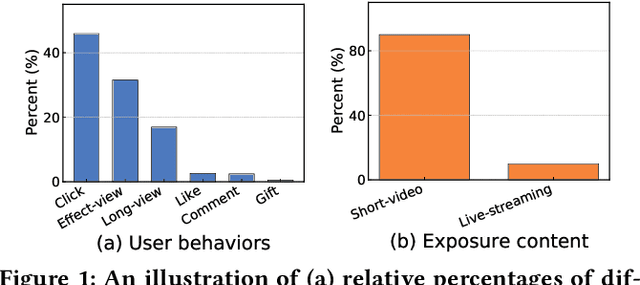

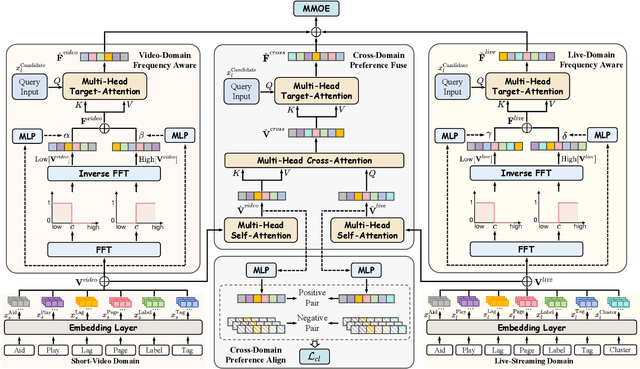

Abstract:Live-streaming services have attracted widespread popularity due to their real-time interactivity and entertainment value. Users can engage with live-streaming authors by participating in live chats, posting likes, or sending virtual gifts to convey their preferences and support. However, the live-streaming services faces serious data-sparsity problem, which can be attributed to the following two points: (1) User's valuable behaviors are usually sparse, e.g., like, comment and gift, which are easily overlooked by the model, making it difficult to describe user's personalized preference. (2) The main exposure content on our platform is short-video, which is 9 times higher than the exposed live-streaming, leading to the inability of live-streaming content to fully model user preference. To this end, we propose a Frequency-Aware Model for Cross-Domain Live-Streaming Recommendation, termed as FARM. Specifically, we first present the intra-domain frequency aware module to enable our model to perceive user's sparse yet valuable behaviors, i.e., high-frequency information, supported by the Discrete Fourier Transform (DFT). To transfer user preference across the short-video and live-streaming domains, we propose a novel preference align before fuse strategy, which consists of two parts: the cross-domain preference align module to align user preference in both domains with contrastive learning, and the cross-domain preference fuse module to further fuse user preference in both domains using a serious of tailor-designed attention mechanisms. Extensive offline experiments and online A/B testing on Kuaishou live-streaming services demonstrate the effectiveness and superiority of FARM. Our FARM has been deployed in online live-streaming services and currently serves hundreds of millions of users on Kuaishou.
ChorusCVR: Chorus Supervision for Entire Space Post-Click Conversion Rate Modeling
Feb 12, 2025



Abstract:Post-click conversion rate (CVR) estimation is a vital task in many recommender systems of revenue businesses, e.g., e-commerce and advertising. In a perspective of sample, a typical CVR positive sample usually goes through a funnel of exposure to click to conversion. For lack of post-event labels for un-clicked samples, CVR learning task commonly only utilizes clicked samples, rather than all exposed samples as for click-through rate (CTR) learning task. However, during online inference, CVR and CTR are estimated on the same assumed exposure space, which leads to a inconsistency of sample space between training and inference, i.e., sample selection bias (SSB). To alleviate SSB, previous wisdom proposes to design novel auxiliary tasks to enable the CVR learning on un-click training samples, such as CTCVR and counterfactual CVR, etc. Although alleviating SSB to some extent, none of them pay attention to the discrimination between ambiguous negative samples (un-clicked) and factual negative samples (clicked but un-converted) during modelling, which makes CVR model lacks robustness. To full this gap, we propose a novel ChorusCVR model to realize debiased CVR learning in entire-space.
Multifaceted User Modeling in Recommendation: A Federated Foundation Models Approach
Dec 22, 2024



Abstract:Multifaceted user modeling aims to uncover fine-grained patterns and learn representations from user data, revealing their diverse interests and characteristics, such as profile, preference, and personality. Recent studies on foundation model-based recommendation have emphasized the Transformer architecture's remarkable ability to capture complex, non-linear user-item interaction relationships. This paper aims to advance foundation model-based recommendersystems by introducing enhancements to multifaceted user modeling capabilities. We propose a novel Transformer layer designed specifically for recommendation, using the self-attention mechanism to capture sequential user-item interaction patterns. Specifically, we design a group gating network to identify user groups, enabling hierarchical discovery across different layers, thereby capturing the multifaceted nature of user interests through multiple Transformer layers. Furthermore, to broaden the data scope and further enhance multifaceted user modeling, we extend the framework to a federated setting, enabling the use of private datasets while ensuring privacy. Experimental validations on benchmark datasets demonstrate the superior performance of our proposed method. Code is available.
QARM: Quantitative Alignment Multi-Modal Recommendation at Kuaishou
Nov 18, 2024



Abstract:In recent years, with the significant evolution of multi-modal large models, many recommender researchers realized the potential of multi-modal information for user interest modeling. In industry, a wide-used modeling architecture is a cascading paradigm: (1) first pre-training a multi-modal model to provide omnipotent representations for downstream services; (2) The downstream recommendation model takes the multi-modal representation as additional input to fit real user-item behaviours. Although such paradigm achieves remarkable improvements, however, there still exist two problems that limit model performance: (1) Representation Unmatching: The pre-trained multi-modal model is always supervised by the classic NLP/CV tasks, while the recommendation models are supervised by real user-item interaction. As a result, the two fundamentally different tasks' goals were relatively separate, and there was a lack of consistent objective on their representations; (2) Representation Unlearning: The generated multi-modal representations are always stored in cache store and serve as extra fixed input of recommendation model, thus could not be updated by recommendation model gradient, further unfriendly for downstream training. Inspired by the two difficulties challenges in downstream tasks usage, we introduce a quantitative multi-modal framework to customize the specialized and trainable multi-modal information for different downstream models.
A Unified Framework for Cross-Domain Recommendation
Sep 06, 2024



Abstract:In addressing the persistent challenges of data-sparsity and cold-start issues in domain-expert recommender systems, Cross-Domain Recommendation (CDR) emerges as a promising methodology. CDR aims at enhancing prediction performance in the target domain by leveraging interaction knowledge from related source domains, particularly through users or items that span across multiple domains (e.g., Short-Video and Living-Room). For academic research purposes, there are a number of distinct aspects to guide CDR method designing, including the auxiliary domain number, domain-overlapped element, user-item interaction types, and downstream tasks. With so many different CDR combination scenario settings, the proposed scenario-expert approaches are tailored to address a specific vertical CDR scenario, and often lack the capacity to adapt to multiple horizontal scenarios. In an effect to coherently adapt to various scenarios, and drawing inspiration from the concept of domain-invariant transfer learning, we extend the former SOTA model UniCDR in five different aspects, named as UniCDR+. Our work was successfully deployed on the Kuaishou Living-Room RecSys.
Moment&Cross: Next-Generation Real-Time Cross-Domain CTR Prediction for Live-Streaming Recommendation at Kuaishou
Aug 11, 2024



Abstract:Kuaishou, is one of the largest short-video and live-streaming platform, compared with short-video recommendations, live-streaming recommendation is more complex because of: (1) temporarily-alive to distribution, (2) user may watch for a long time with feedback delay, (3) content is unpredictable and changes over time. Actually, even if a user is interested in the live-streaming author, it still may be an negative watching (e.g., short-view < 3s) since the real-time content is not attractive enough. Therefore, for live-streaming recommendation, there exists a challenging task: how do we recommend the live-streaming at right moment for users? Additionally, our platform's major exposure content is short short-video, and the amount of exposed short-video is 9x more than exposed live-streaming. Thus users will leave more behaviors on short-videos, which leads to a serious data imbalance problem making the live-streaming data could not fully reflect user interests. In such case, there raises another challenging task: how do we utilize users' short-video behaviors to make live-streaming recommendation better?
Federated Adaptation for Foundation Model-based Recommendations
May 08, 2024



Abstract:With the recent success of large language models, particularly foundation models with generalization abilities, applying foundation models for recommendations becomes a new paradigm to improve existing recommendation systems. It becomes a new open challenge to enable the foundation model to capture user preference changes in a timely manner with reasonable communication and computation costs while preserving privacy. This paper proposes a novel federated adaptation mechanism to enhance the foundation model-based recommendation system in a privacy-preserving manner. Specifically, each client will learn a lightweight personalized adapter using its private data. The adapter then collaborates with pre-trained foundation models to provide recommendation service efficiently with fine-grained manners. Importantly, users' private behavioral data remains secure as it is not shared with the server. This data localization-based privacy preservation is embodied via the federated learning framework. The model can ensure that shared knowledge is incorporated into all adapters while simultaneously preserving each user's personal preferences. Experimental results on four benchmark datasets demonstrate our method's superior performance. Implementation code is available to ease reproducibility.
End-to-end training of Multimodal Model and ranking Model
Apr 09, 2024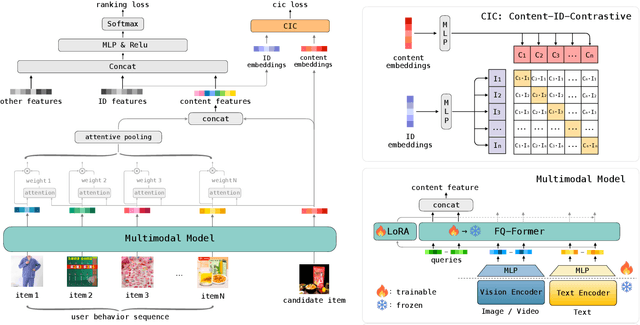
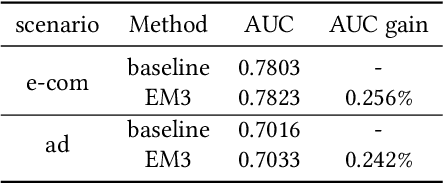
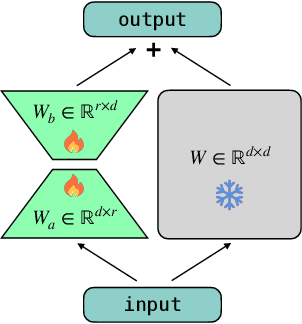
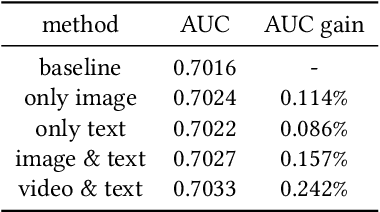
Abstract:Traditional recommender systems heavily rely on ID features, which often encounter challenges related to cold-start and generalization. Modeling pre-extracted content features can mitigate these issues, but is still a suboptimal solution due to the discrepancies between training tasks and model parameters. End-to-end training presents a promising solution for these problems, yet most of the existing works mainly focus on retrieval models, leaving the multimodal techniques under-utilized. In this paper, we propose an industrial multimodal recommendation framework named EM3: End-to-end training of Multimodal Model and ranking Model, which sufficiently utilizes multimodal information and allows personalized ranking tasks to directly train the core modules in the multimodal model to obtain more task-oriented content features, without overburdening resource consumption. First, we propose Fusion-Q-Former, which consists of transformers and a set of trainable queries, to fuse different modalities and generate fixed-length and robust multimodal embeddings. Second, in our sequential modeling for user content interest, we utilize Low-Rank Adaptation technique to alleviate the conflict between huge resource consumption and long sequence length. Third, we propose a novel Content-ID-Contrastive learning task to complement the advantages of content and ID by aligning them with each other, obtaining more task-oriented content embeddings and more generalized ID embeddings. In experiments, we implement EM3 on different ranking models in two scenario, achieving significant improvements in both offline evaluation and online A/B test, verifying the generalizability of our method. Ablation studies and visualization are also performed. Furthermore, we also conduct experiments on two public datasets to show that our proposed method outperforms the state-of-the-art methods.
 Add to Chrome
Add to Chrome Add to Firefox
Add to Firefox Add to Edge
Add to Edge